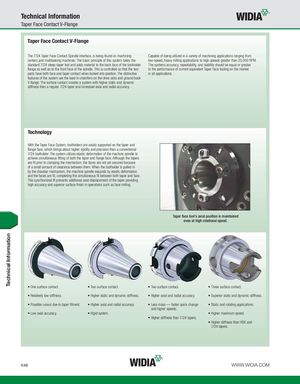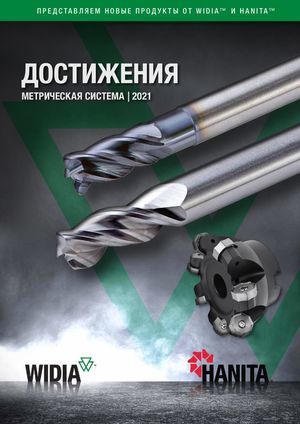Каталог Widia инструментальная оснастка - страница 1084
Навигация

Technical Information Taper Face Contact V-Flange Taper Face Contact V-Flange The 7/24 Taper Face Contact Spindle Interface, is being found on machining Capable of being utilized in a variety of machining applications ranging from centers and multitasking machines. The basic principle of this system takes the low-speed, heavy milling applications to high speeds greater than 20,000 RPM. standard 7/24 steep-taper tool and adds material to the back face of the toolholder The systems accuracy, repeatability, and stability should be equal or greater flange as well as to the front face of the spindle. This is controlled so that the two to the performance of current equivalent Taper Face tooling on the market parts have both face and taper contact when locked into position. The distinctive in all applications. features of the system are the lead-in chamfers on the drive slots and ground back V-flange. The surface contact creates a system with higher static and dynamic stiffness than a regular 7/24 taper and increased axial and radial accuracy. Technology With the Taper Face System, toolholders are axially supported on the taper and flange face, which brings about higher rigidity and precision than a conventional 7/24 toolholder. The system utilizes elastic deformation of the machine spindle to achieve simultaneous fitting of both the taper and flange face. Although the tapers are fit prior to clamping the mechanism, the faces are not yet secured because of a small amount of clearance between them. When the toolholder is pulled in by the drawbar mechanism, the machine spindle expands by elastic deformation and the faces are fit, completing the simultaneous fit between both taper and face. This synchronized fit prevents additional axial displacement of the taper providing high accuracy and superior surface finish in operations such as face milling. Taper face tool's axial position is maintained even at high rotational speed. • One surface contact. • Two surface contact. • Two surface contact. • Three surface contact. • Relatively low stiffness. • Higher static and dynamic stiffness. • Higher axial and radial accuracy. • Superior static and dynamic stiffness. • Possible runout due to taper fitment. • Higher axial and radial accuracy. • Less mass — faster quick change • Static and rotating applications. and higher speeds. • Low axial accuracy. • Rigid system. • Higher maximum speed. • Higher stiffness than 7/24 tapers. • Higher stiffness than HSK and 7/24 tapers. K48 WWW.WIDIA.COM Technical Information
 Каталог Widia достижения 2021
Каталог Widia достижения 2021 Брошюра Widia решения для аэрокосмической промышленности
Брошюра Widia решения для аэрокосмической промышленности Брошюра Widia техническое руководство
Брошюра Widia техническое руководство Каталог Widia токарный инструмент 2020
Каталог Widia токарный инструмент 2020 Каталог Widia цельные концевые фрезы
Каталог Widia цельные концевые фрезы Каталог Widia техническое руководство по разверткам
Каталог Widia техническое руководство по разверткам